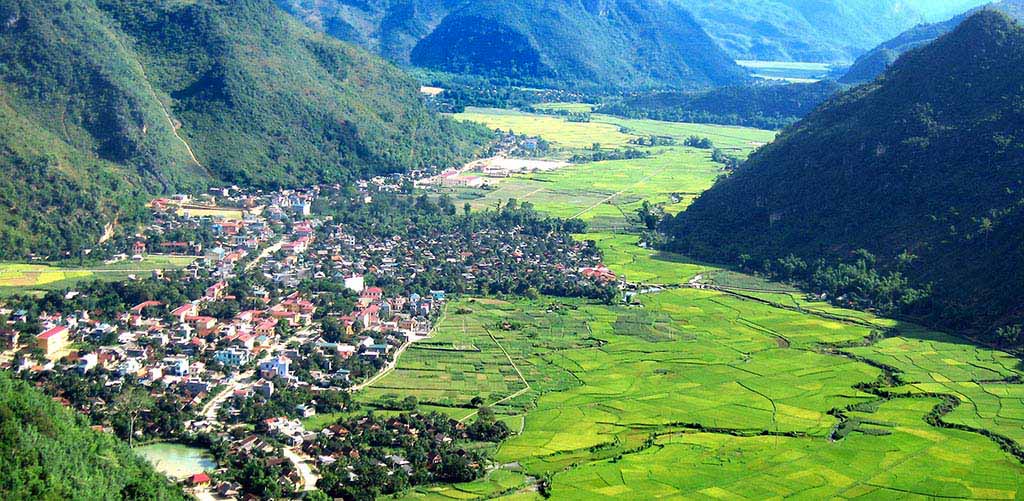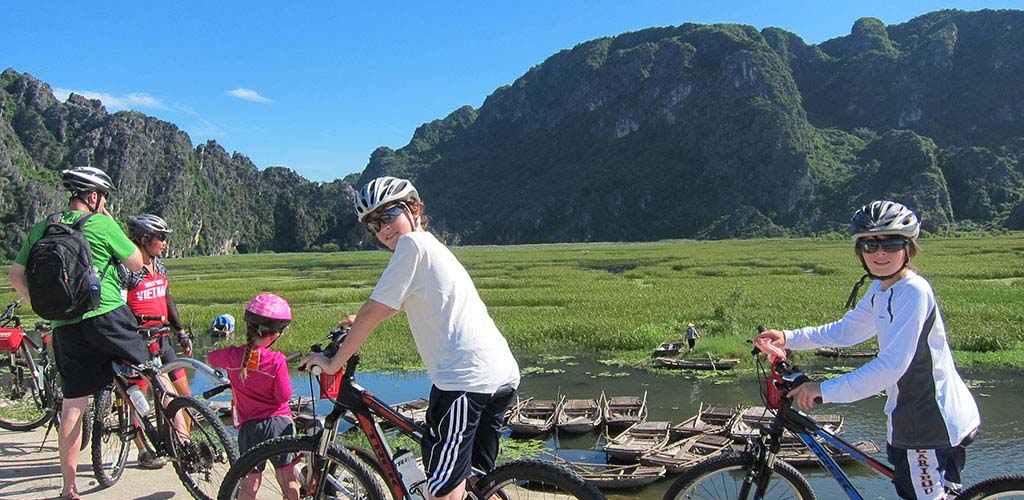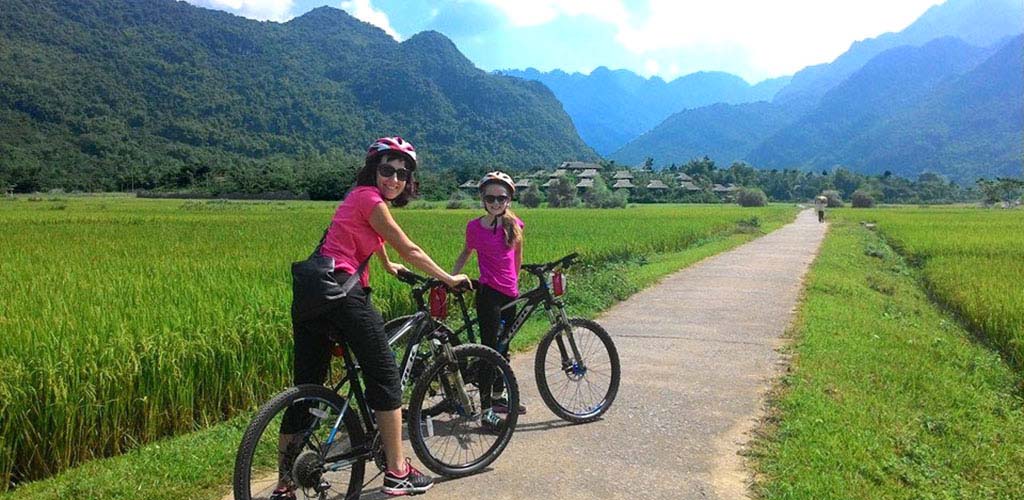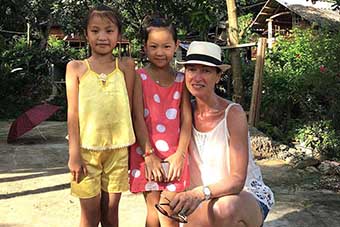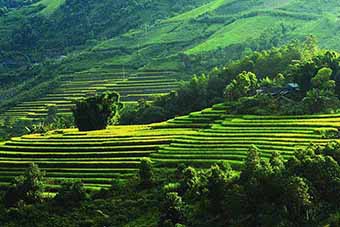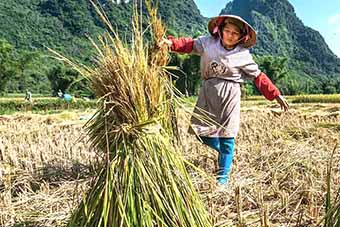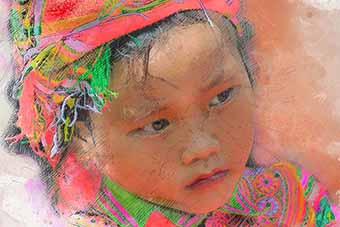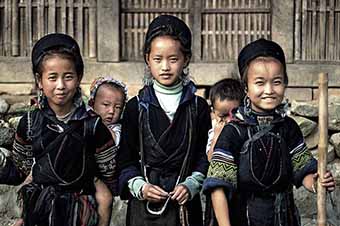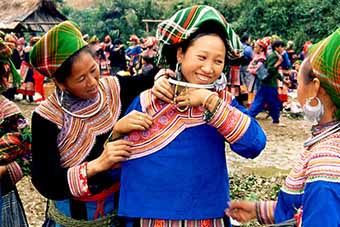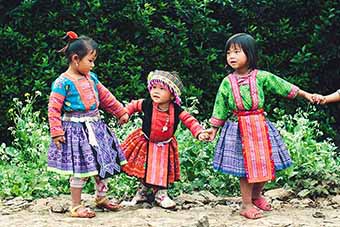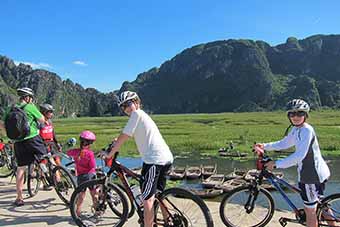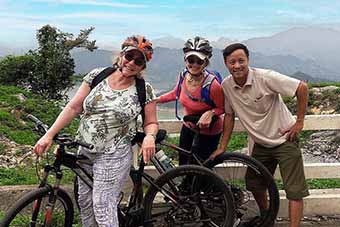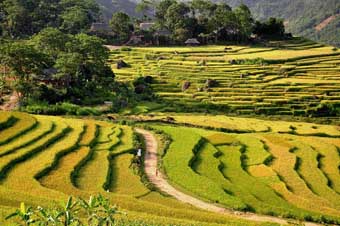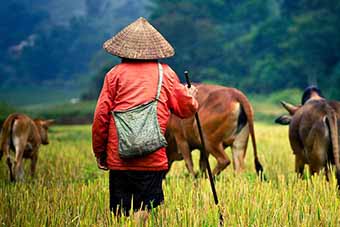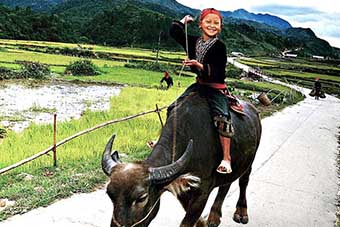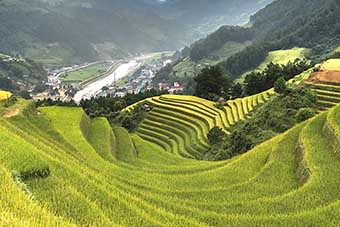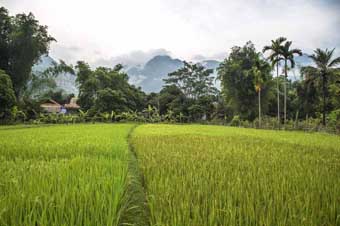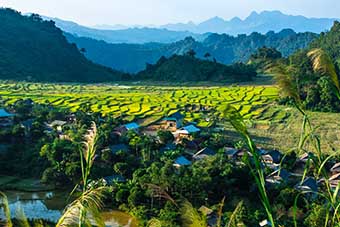

The small town of Mai Chau lies in a picturesque valley of karst of the same name. Mai Chau offers some of the most spectacular scenery in Vietnam with a patchwork quilt of emerald green rice paddies, small rustic farms, and long house villages occupied by a colorful myriad of traditional hilltribes, mostly Tai and H'mong, sparsely scattered around the area. The Pu Luong Nature Reserve is nearby, with stunning views of jungle and terraced rice fields. The striking karst towering all around is of the same geographic formations on Halong Bay, so much so that the are is nicknamed "The Dry Halong Bay."
Mai Chau sees only a trickle of tourists for now and is definitely a "see it now" unspoiled destination. At low elevation, Mai Chau is more pleasant weather-wide than the far off high northern mountains, which are often socked in with clouds and chilly temperatures in winter. In the spring, Mai Chau displays a riot of color with blooming flowers and peach blossoms and in October, golden fields of rice about to be harvested. Our trips provide immersive and authentic encounters with local hilltribes, and escape into the hills - by foot or bike - to enjoy the remote scenery up close.

Why Visit Mai Chau?
![]() Newer and comfortable eco-lodges
Newer and comfortable eco-lodges
![]() Hilltribes—a last glimpse of traditional peoples whose lifestyles will change dramatically over the next decade
Hilltribes—a last glimpse of traditional peoples whose lifestyles will change dramatically over the next decade
![]() Outdoor adventure: One of the best places for hiking and cycling (we also now have imported Giant e-bikes)
Outdoor adventure: One of the best places for hiking and cycling (we also now have imported Giant e-bikes)
![]() Striking karst scenery, which gives the area the nickname "the Dry Halong Bay"
Striking karst scenery, which gives the area the nickname "the Dry Halong Bay"
![]() Family adventures—fascinating and enjoyable for kids of all ages
Family adventures—fascinating and enjoyable for kids of all ages
![]() More remote and different than any other place you will visit in Vietnam
More remote and different than any other place you will visit in Vietnam
![]() Warmer, closer to Hanoi and less touristy and developed than Sapa or Ninh Binh
Warmer, closer to Hanoi and less touristy and developed than Sapa or Ninh Binh
Mai Chau Hilltribes
From your base in Mai Chau, stroll or cycle through rice paddies meandering through nearby Tai villages. The Tais live in raised wooden long houses in the shape of tortoise shells, with sloping roofs made from palm or sugarcane leaves. Inside are polished bamboo-slat floors with woven mats, a fireplace for cooking, and a hand loom; buffalo, chickens, and pigs live under the house, with fishponds around.
H'mong villages lie further out in the hills, often in village houses composed of simple huts with earthen floors. The H'mong women wear elaborately patterned and colorful tops and skirts (a full outfit can take up to three years to embroider) reflecting what group of Hmong they are from such as Green, Black (right with the telltale indigo dyed hands), Red, White, and Flower. H'mong men in the area still smoke opium.
Opposite the bus station in Mai Chau is the central covered market, visited by hilltribe groups in the area on Sundays and some other special dates. In the Tai village there are traditional long houses which have been adapted for use by visitors and there are a dozen long houses here accepting foreign guests on a regular basis.
The Tai women will also stage a delightful traditional dance soiree; the repertoire includes the delicate butterfly dance (performed with fans) and the striking bamboo dance (daintily dodging bamboo sticks that are smashed together); the performance is followed by a large pot of Tai home brew rice wine, complete with super long bamboo straws.
Using the village as a base camp, trek out through rice paddy trails to outlying villages in the area. On these treks you can attune yourself to the rhythms of rural life watching locals harvesting rice, carrying baskets of goods around, or thatching of a new house. A two-day trip is a perfect escape, but longer treks of up to four days, with varying degrees of difficulty, are including exploration of nearby Puluong National Park and further out to Cuc Phuong National Park and the karst landscapes of Ninh Binh (known as the "dry Halong Bay").
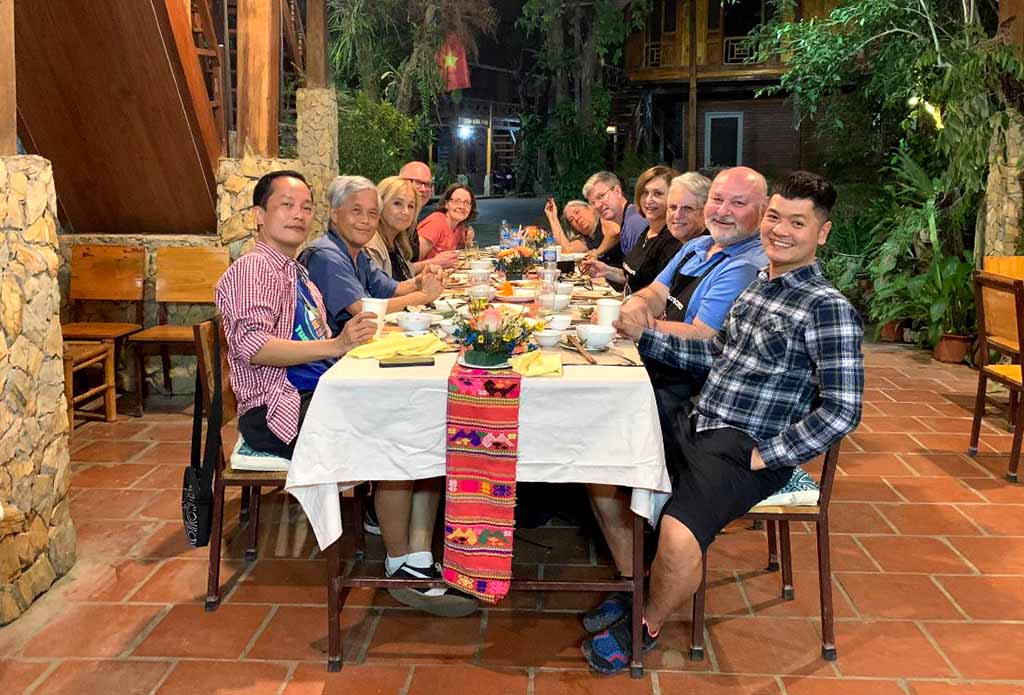
Activities include cooking classes (above), swimming, cycling, local markets, light trekking, and visiting local crafts and small workshops such as a chopstick maker. Son Doong Caves, the largest caves in the world discovered in 2009, are also not far from here (but require a week-long hiking program). En route to Mai Chau by private car, we can also pause at Man Due, a town close to Mai Chau with great karst scenery. All in all, Mai Chau offers an easy escape from Hanoi but remains world's away for the time being.
Mai Chau's Great Outdoors
Mai Chau offers some of the country's most scenic hiking and biking, from short, leisurely rides and walks through the valley along the river or longer treks into Puluong National Park (below). The valleys footpaths are away from traffic, meandering through villages and farms. If there are hilltribe markets in the area, we will visit early while busy.
As we like to arrange in several other places in the region, including Inle Lake in Myanmar, Luang Prabang in Laos, and in Hue and Mai Chau on the Vietnamese central coast, there's remote access and adventure afforded loading bikes onto small boats and heading up or down stream.
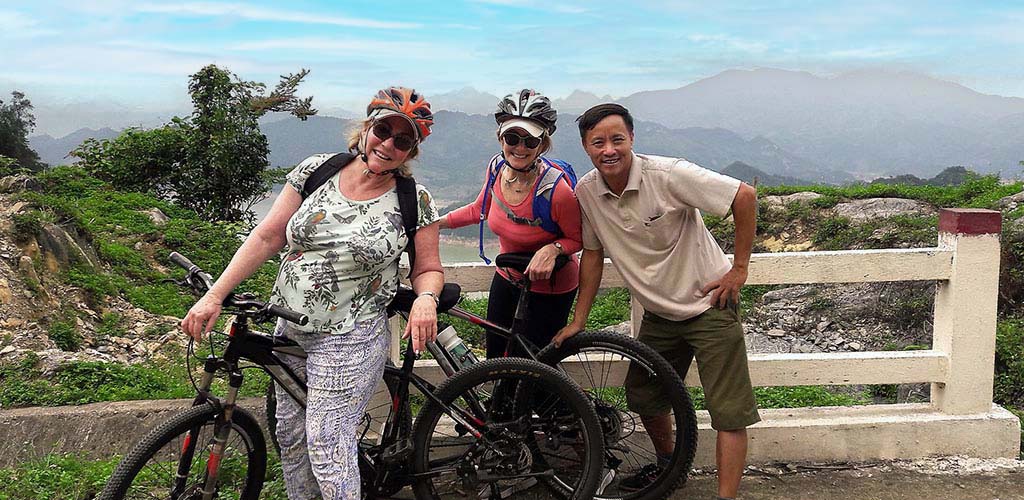
Cycling Mau Chau
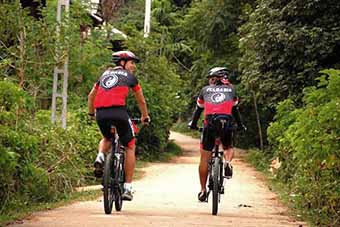 The best area for cycling in Vietnam. For over 20 years we have been coming here with our cycling trips (www.veloasia.com), for a day or even longer, with cycling trips for casual bikers, or longer tours touring cyclists riding around this picturesque region of Vietnam or all the way to Luang Prabang .
The best area for cycling in Vietnam. For over 20 years we have been coming here with our cycling trips (www.veloasia.com), for a day or even longer, with cycling trips for casual bikers, or longer tours touring cyclists riding around this picturesque region of Vietnam or all the way to Luang Prabang .
Within the Mai Chau Valley, quiet foothpaths with no automobile traffic meander through local villages and farms, over the river, nestled between towering karst peaks offering idyllic pedaling. We can also cycle through nearby Pu Luong National Park, admiring the terraced rice fields and jungle setting. For those less wanting to ride longer with assistance, we can arrange imported Giant e-bikes as an option.
Mai Chau Accommodation

Lodges
Newer lodges are rustic, but elegant, clean and comfortable with traditional wooden architecture. Many of Mai Chau valleys attractions are close by, a White Thai village only several hundred yards away and from here we can plan several biking routes. There is a large lounge and restaurant. A pool offers a refreshing place for a dip and to relax post-hike. There are a limited number of spacious rooms that do not face the roadway, and these book early in the season. Lodges do have Wifi.
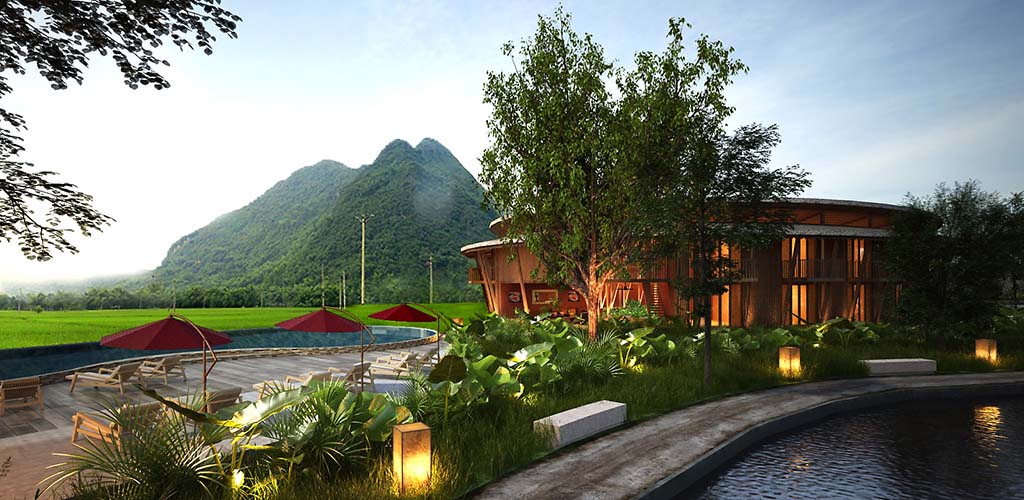
Homestays
We arrange, seasonally, with one family to share their home on a private basis (no other travelers will be in the home) and have brought our own bedding and other conveniences from Hanoi to make the stay a comfortable one with a simple fold-up mattress and mosquito net.
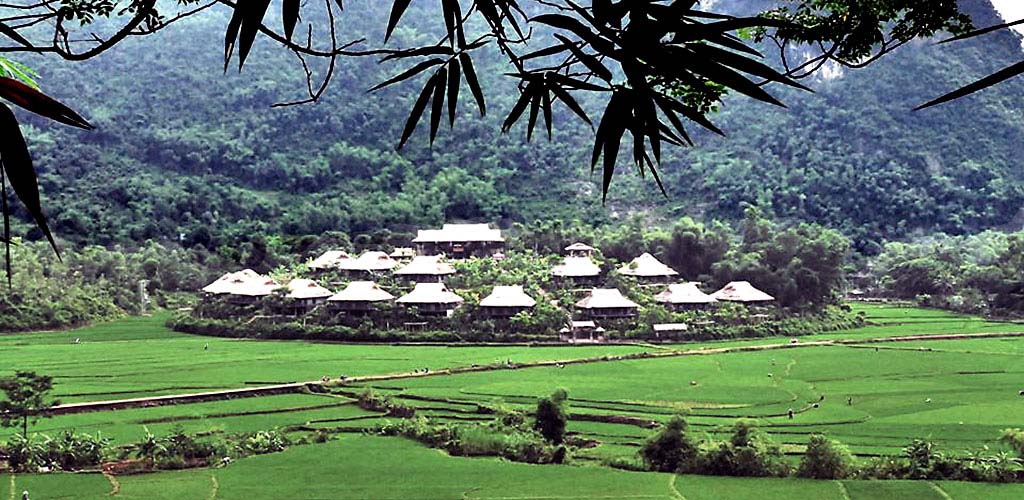
The long house family arranges for food to be served, local style, on the floor. Staying in a long house gives you an opportunity to see how the locals live, although slightly commercialized — with a a stock of items for sale to tourists passing through the area. For less adventurous accommodation, the comfortable Mai Chau Lodge has opened with fabulous views over the valley.
When to go?
Late October and early November is the vivid harvest season, when the terraced fields are golden yellow with pleasant weather. Mai Chau can be cool and cloudy, much like Halong Bay, from late December until the beginning of March dipping into the low 60s or 17 Celsius (though Sapa can be at or below freezing during these months), and it if sunshine is paramount on your trip, we recommend heading south to Mai Chau on the central coast. For sunshine, Mai Chau is best to visit from March through June and even warmer July. September can be rainy, although not everyday.
